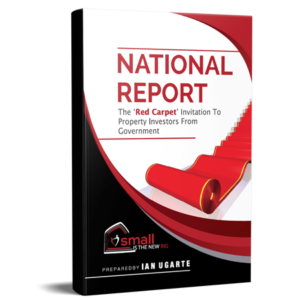I’ve been learning lessons about co-living and HI-RES for 12 years, ever since I realised what a corker of an idea it was. At that time, there were no experts in it.
So I did my own investing, making all the mistakes, asking the questions so I could become the expert and teach people – through courses, webinars, podcasts, guest speaking gigs – how to do this for themselves.
It’s very frustrating, as a teacher, hearing these old chestnuts come up time and again. Let’s look at 6 of the worst misunderstandings about co-living-style cashflow investment property and why they’re WRONG!
SCROLL DOWN to find out the 6 top myths and misunderstandings about co-living.

1. Families are the biggest market for our investments, and we’ll exclude them if we create small apartments
OK, this is a total myth. The data just doesn’t support it. In fact, the renter demographic that is actually increasing is singles and couples, not families.
Yet, as of the 2021 census, we still build the largest houses in the world in Australia – 256m2 on average, 319m2 on average in Western Australia! To put that into perspective, you can fit 22.6 average Hong Kong-sized houses in one Australian house! And because of that over-speccing, we have 13.5 million empty bedrooms every night in Australia.
The mismatch that we have in Australia right now, is that the demographic really in need of properties – that is suffering and struggling to get into them – aren’t the people who are getting properties built for them.
Right now, 60 to 80% of people looking for accommodation are singles or couples, but 60 to 80% of all the rental properties are three-, four- and five-bedroom houses. And that disconnect just gets worse, based on the new data out of the 2021 census.
Bottom line: if you’re going to invest in a property and you’re focusing on a new family home, you’re making a mistake.
First up, you’ll be tying yourself up into a negatively geared investment because no-one can have a positive yield with interest rates rising potentially to 7%. Secondly, you’ll have a cookie-cutter product like everyone else, so you’re fighting with everyone else to find the right people for your rental property.
And thirdly, you’re giving up the multiple cash flow investment opportunities you could be receiving if you had a co-living property. We’ve done co-living properties from Perth to the Gold Coast that are easily earning $1,200 to $1,400 a week for four apartments.
People say to me all the time: you took a family home away from the market! And I say, yes, I did. I took this family home away from the market, and out of that one front door, I created five front doors.
And now, the bigger properties where the singles and couples were forced to live before, paying rents that were beyond their means, have been freed up for families to live in.

2. My residents will be plucked from the lowest echelons of society: drug dealers, paedophiles, etc.
Observing the co-living projects we’ve been part of in the last 10 years, there are three main groups of renters living in micro-apartments.
Group 1:
20- to 30-year-old singles who have just come out of university or started in the workforce. Often they’re project managers, tradies, nurses, engineers, doctors, lawyers, teachers still making their mark.
Group 2:
Couples – 30 to 45 years old – who have been enjoying a great lifestyle but have now decided they want kids. Renting a self-contained micro-apartment means they can save money on rent, they can work really long hours for the next three to five years to save money, at which point they buy their own home and have a baby. They don’t have time to cook, so a kitchenette suits them fine most of the time.
Group 3:
This third group surprised me the most when we first started advertising our co-living apartments: the 55-plus single female renter. We were one of the first organisations in the country to realise that this is the biggest growing demographic of homelessness in Australia right now.
She’s typically looked after her own home for 20 to 30 years and ends up in a messy divorce after the kids have left home. She takes a really crappy divorce pay-out and finds herself in a position where renting a property is too expensive. She can’t get a job because she doesn’t have the work experience required, despite years of running a busy household. She has little to no super and might also be looking after elderly parents.
All these groups are what we used to call “middle-class”, not that undesirable element that investors fear. And all of these groups expect a neat, tidy unit where they can live comfortably, a place they can call home.
Read some first hand accounts from happy co-living residents HERE.

3. Creating disability accommodation is an easy win
There are some outrageous claims circulating at the moment about returns people can get investing in NDIS specialist disability accommodation (SDA) – anywhere from 16 to 20% returns. I urge you to look deeper. Capitalism and disability do not work well together. And while the government has “promised” funding for these kinds of properties, right now the ACCC is looking closely at marketeers promising returns that are not guaranteed. (This is based on multiple complaints from investors who have purchased NDIS and SDA properties and are not receiving the returns promised, or worse – no returns at all.)
Be warned: this is not a Kevin Costner ‘Field of Dreams’ scenario. If you build an NDIS property, they will not necessarily come. There are multiple empty properties across the country because the NDIS SDA is a very particular type of rental property that relies on many moving parts for it to work, including the NDIS making fast decisions.
And even if your tenant signs a five-year lease, they actually only need to give you two months’ notice that they’re moving out because they’re in a disability scenario and covered by the Disability Discrimination Act.
If you get attracted by the shiny lights then be aware that the light bulb could shatter.

4. When you divide up a house into separate, self-contained apartments, it’s irreversible
Simply not true. If you convert a family home to co-living, and later decide you want to convert it back to a normal family house, it will take INVIDA all of two days and about $10,000.
Here’s an example. One of our Victorian-based client couples bought a home in Noosa, Queensland. The plan is to sell up their Victorian property in the next 10 years and move to Noosa, which will become their family home. They knew prices would go up (which they have, exponentially) so they wanted to buy it sooner rather than later.
In the meantime, they wanted cashflow. So they converted the property and they’re getting paid a gross yield of 10.27%. That’s $46,000 more income per year, than if they’d been renting it as a regular home. So the cost and effort of eventually converting it back pales in comparison to cashflow gains.
Take a look at some of our co-living conversions in our Success Stories, HERE.

5. Co-living properties / micro-apartments are worth less when you go to sell them
Can you easily sell a co-living property? Absolutely. It’s true that we don’t have a lot of data to show valuers so it can be more difficult to value these kinds of cash flow investment properties. But if you do want to convert or purpose-build one, and you want to sell it in the future, come see me because I’ve got people lined up to buy them, especially when they’ve got established cash flow.
The simplest way to explain it is this. Say you’re an investor, and you’re looking to buy something in Brisbane for $750,000. You’ve got two properties side by side for sale, a standard property that rents for $750 a week and the property next door that rents for $1,500 a week. The $1,500-a-week option will trump the other one every day of the week. Also, from what we’ve observed, people are willing to pay a premium to buy that extra cashflow – roughly $100,000 or $150,000 extra.
As the data trickles in and more of these kinds of properties are sold (not too many, they’re too lucrative!) it’s clearer and clearer that yes, you can sell the property, and probably for more.
6.Negative gearing is a better strategy for property investment
I beg to differ. Negative gearing is the most ridiculous, stupid strategy anyone’s ever invested in. No one buys a business to lose money on purpose so they can get their tax back. So why would you do it in property. And if you still want to do it, I’m happy for you to give me $1 so that I can give you 30 cents back.
JOIN MY UPCOMING WEBINAR to learn more about how INVIDA co-living cash flow positive properties can get you to your financial goals sooner! Register HERE.







